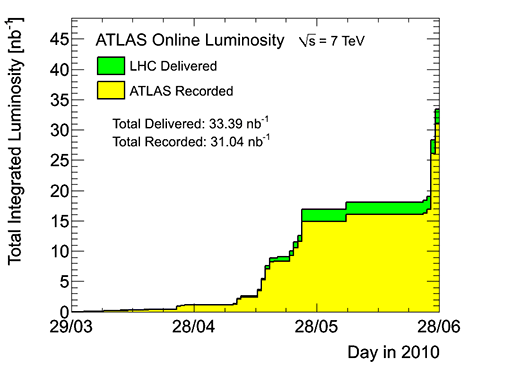
ATLAS e-News
23 February 2011
LHC leaps ahead
28 June 2010

Total integrated luminosity collected by ATLAS
Three weeks ago, the LHC experiments agreed to an extended machine development phase, ending all physics runs for the time being as the LHC worked up to continuous running with nominal bunches containing 1.15 x 1011 protons.
As soon as just two of these ‘fat bunches’ were colliding last Saturday night (June 26th, the total volume of data collected by ATLAS since March 30th) almost doubled, from 16 nb-1 to 30 nb-1, delivering some early payoff for adopting this strategy.
“Payoff is a complex concept,” considers Run Coordinator Benedetto Gorini, carefully. “We certainly believe that it will pay off for the total luminosity by the end of the year. But it may not pay off at all before ICHEP.”
ATLAS's position had to be formulated extremely quickly when the LHC proposed the extended commission. “Martin [Aleksa, Deputy Run Coordinator] and myself had a long discussion over the phone with Fabiola [Gianotti, ATLAS Spokesperson], because she was in DESY at the PLHC conference at the time,”says Benedetto. “She discussed with the machine experts and the other experiments' Spokespeople, who were all there too. It was a very active time.”
The alternative, conservative, approach would have been to collect as much data as possible with the tried-and-tested smaller bunches before ICHEP, and commission for nominal bunches later. In the end though, the consensus following a "long and fruitful discussion" with the other experiments was to go for the machine development phase immediately, and then come back with a vengeance at much higher luminosity.
Continuous stable beam physics with nominal bunches began on Friday 25th June. Analyses were due to be completed for approval at the Copenhagen ATLAS week which kicked off on Monday, but according to Spokesperson Fabiola Gianotti, the data collected over the last weekend of record luminosity should be able to be "largely incorporated" into the ICHEP output. Aside from statistical analyses, any physics candidates which are identified in the data being taken now will of course also be fair game for showing at the upcoming conference.
Regardless of the size of the ICHEP dataset, everyone agrees that getting commissioning out of the way in a chunk like this is a big improvement on the old model of interleaving short commissioning phases during the week with short physics runs at the weekends, which had proved to be very inefficient.
“The problem was that before we had two different setups: one for physics, with small bunches – 2 x 1010 protons per bunch – and another for commissioning with final bunches – approximately 1 x 1011 protons per bunch,” Benedetto explains, adding: “Every time you switch, it takes a non-negligible amount of time. All this is time you lose, and we saw by experience that there was a lot of margin for potential mistakes.”
“Going away from the approach of switching continuously between the physics and commissioning setups is certainly going to pay off,” says Benedetto, and with the beam now ready for continuous running with nominal bunches – hitting a peak luminosity 7 x 1029 on Tuesday 29th June – the long-term luminosity goals of the experiments are undoubtedly within easier reach.
 Ceri PerkinsATLAS e-News
|